CADILLAC DTS 2009 1.G User Guide
Manufacturer: CADILLAC, Model Year: 2009, Model line: DTS, Model: CADILLAC DTS 2009 1.GPages: 462, PDF Size: 2.46 MB
Page 11 of 462
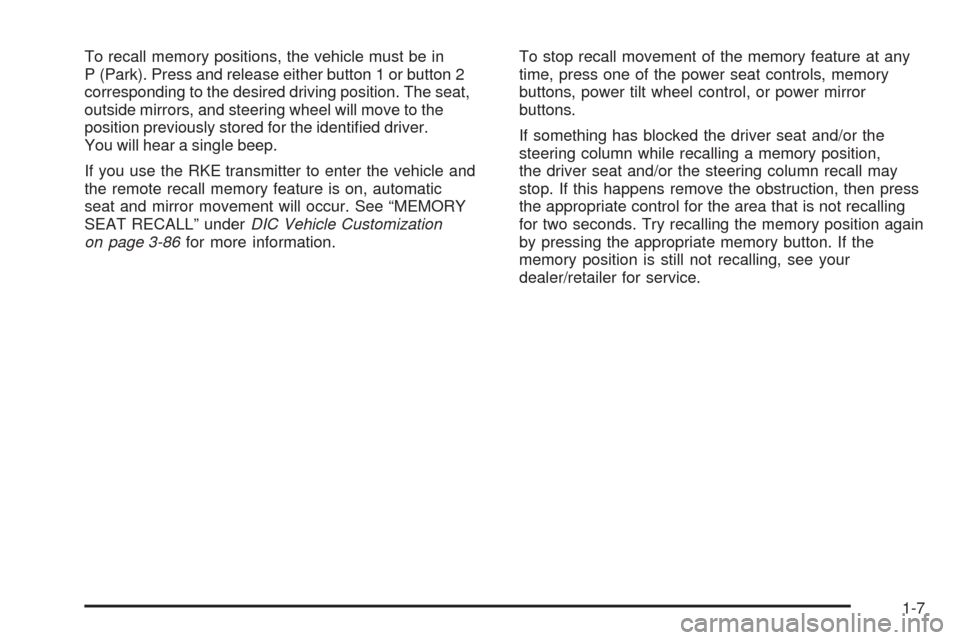
To recall memory positions, the vehicle must be in
P (Park). Press and release either button 1 or button 2
corresponding to the desired driving position. The seat,
outside mirrors, and steering wheel will move to the
position previously stored for the identi�ed driver.
You will hear a single beep.
If you use the RKE transmitter to enter the vehicle and
the remote recall memory feature is on, automatic
seat and mirror movement will occur. See “MEMORY
SEAT RECALL” underDIC Vehicle Customization
on page 3-86for more information.To stop recall movement of the memory feature at any
time, press one of the power seat controls, memory
buttons, power tilt wheel control, or power mirror
buttons.
If something has blocked the driver seat and/or the
steering column while recalling a memory position,
the driver seat and/or the steering column recall may
stop. If this happens remove the obstruction, then press
the appropriate control for the area that is not recalling
for two seconds. Try recalling the memory position again
by pressing the appropriate memory button. If the
memory position is still not recalling, see your
dealer/retailer for service.
1-7
Page 12 of 462
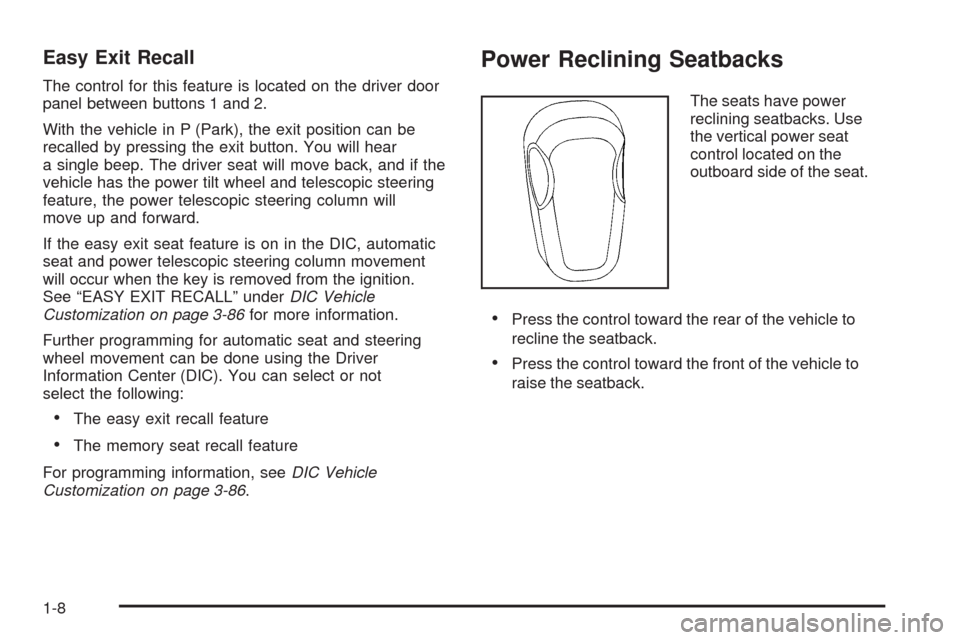
Easy Exit Recall
The control for this feature is located on the driver door
panel between buttons 1 and 2.
With the vehicle in P (Park), the exit position can be
recalled by pressing the exit button. You will hear
a single beep. The driver seat will move back, and if the
vehicle has the power tilt wheel and telescopic steering
feature, the power telescopic steering column will
move up and forward.
If the easy exit seat feature is on in the DIC, automatic
seat and power telescopic steering column movement
will occur when the key is removed from the ignition.
See “EASY EXIT RECALL” underDIC Vehicle
Customization on page 3-86for more information.
Further programming for automatic seat and steering
wheel movement can be done using the Driver
Information Center (DIC). You can select or not
select the following:
The easy exit recall feature
The memory seat recall feature
For programming information, seeDIC Vehicle
Customization on page 3-86.
Power Reclining Seatbacks
The seats have power
reclining seatbacks. Use
the vertical power seat
control located on the
outboard side of the seat.
Press the control toward the rear of the vehicle to
recline the seatback.
Press the control toward the front of the vehicle to
raise the seatback.
1-8
Page 13 of 462
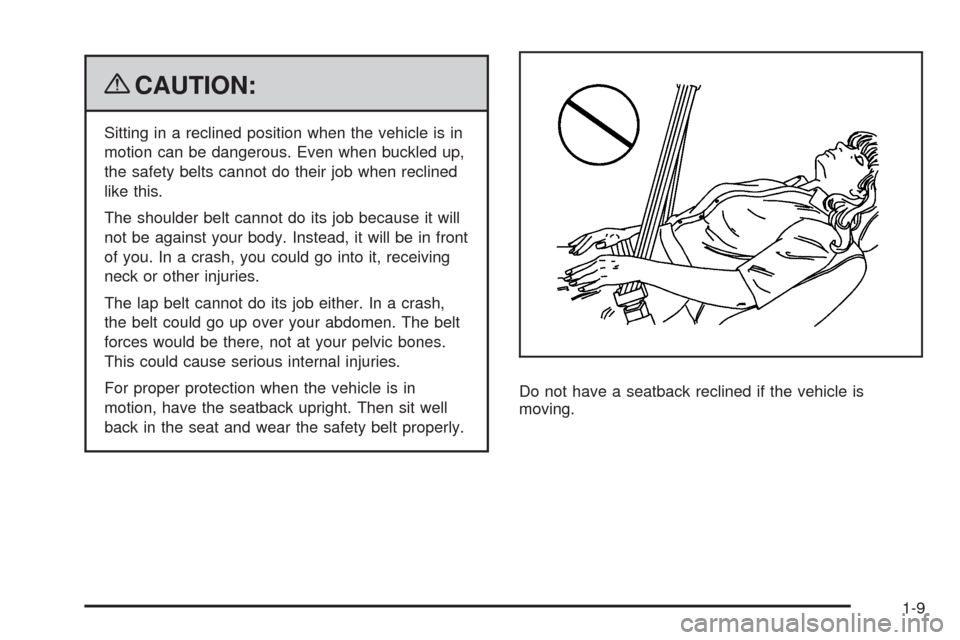
{CAUTION:
Sitting in a reclined position when the vehicle is in
motion can be dangerous. Even when buckled up,
the safety belts cannot do their job when reclined
like this.
The shoulder belt cannot do its job because it will
not be against your body. Instead, it will be in front
of you. In a crash, you could go into it, receiving
neck or other injuries.
The lap belt cannot do its job either. In a crash,
the belt could go up over your abdomen. The belt
forces would be there, not at your pelvic bones.
This could cause serious internal injuries.
For proper protection when the vehicle is in
motion, have the seatback upright. Then sit well
back in the seat and wear the safety belt properly.Do not have a seatback reclined if the vehicle is
moving.
1-9
Page 14 of 462

Center Seat
The vehicle may have a front center seat. This seat
can be converted to a storage area by lowering
the seatback. SeeCenter Flex Storage Unit on
page 2-63.
Rear Seats
Heated Seats
Your vehicle may have heated rear seats.
To operate the rear heated seats, the ignition must be on.
The buttons are located on
the rear doors.
I(Heated Seatback):Press to turn on the heated
seatback.
J(Heated Seat and Seatback):Press to turn on the
heated seat and seatback.
1-10
Page 15 of 462
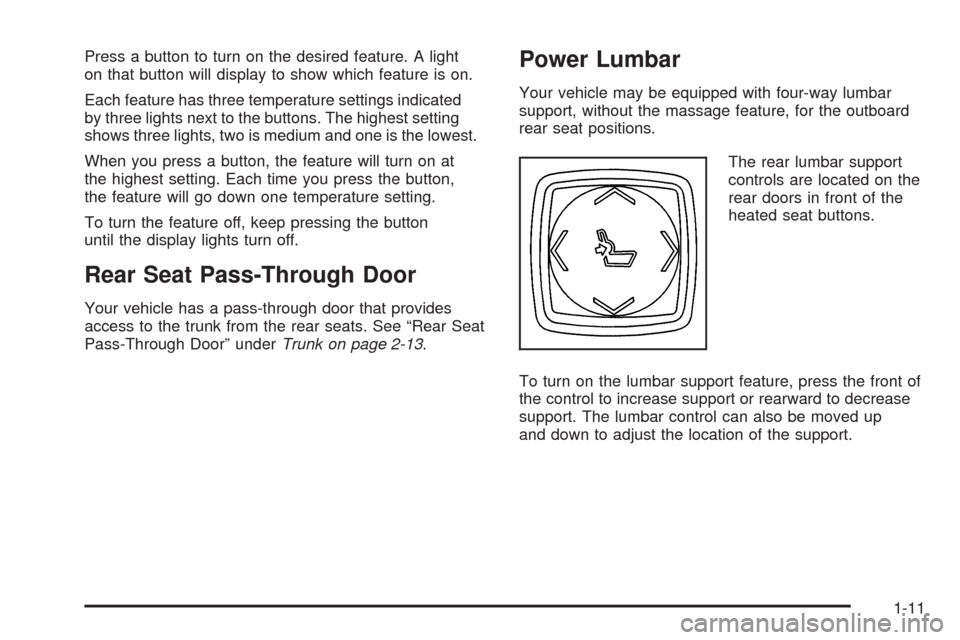
Press a button to turn on the desired feature. A light
on that button will display to show which feature is on.
Each feature has three temperature settings indicated
by three lights next to the buttons. The highest setting
shows three lights, two is medium and one is the lowest.
When you press a button, the feature will turn on at
the highest setting. Each time you press the button,
the feature will go down one temperature setting.
To turn the feature off, keep pressing the button
until the display lights turn off.
Rear Seat Pass-Through Door
Your vehicle has a pass-through door that provides
access to the trunk from the rear seats. See “Rear Seat
Pass-Through Door” underTrunk on page 2-13.
Power Lumbar
Your vehicle may be equipped with four-way lumbar
support, without the massage feature, for the outboard
rear seat positions.
The rear lumbar support
controls are located on the
rear doors in front of the
heated seat buttons.
To turn on the lumbar support feature, press the front of
the control to increase support or rearward to decrease
support. The lumbar control can also be moved up
and down to adjust the location of the support.
1-11
Page 16 of 462
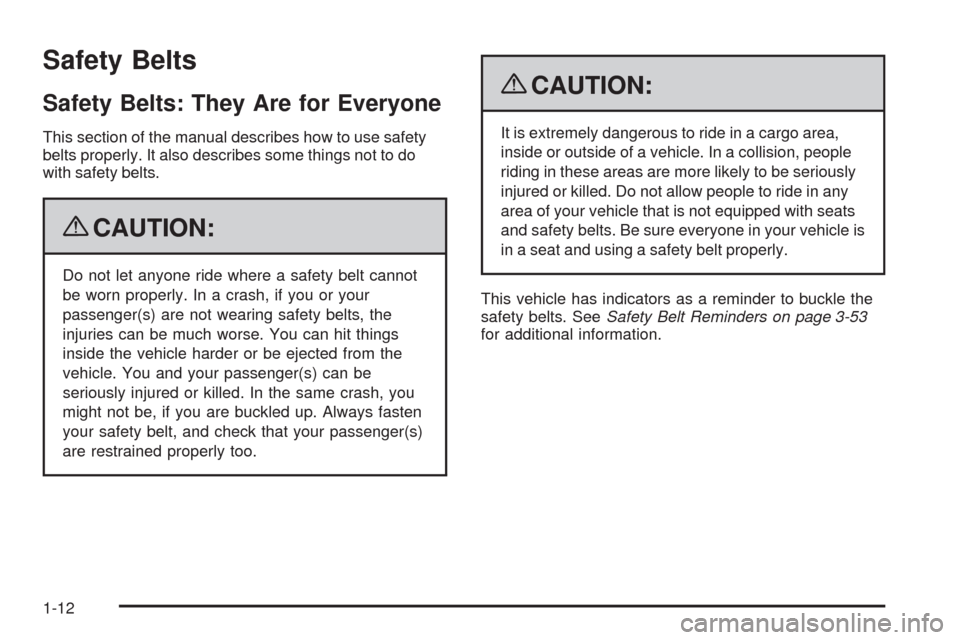
Safety Belts
Safety Belts: They Are for Everyone
This section of the manual describes how to use safety
belts properly. It also describes some things not to do
with safety belts.
{CAUTION:
Do not let anyone ride where a safety belt cannot
be worn properly. In a crash, if you or your
passenger(s) are not wearing safety belts, the
injuries can be much worse. You can hit things
inside the vehicle harder or be ejected from the
vehicle. You and your passenger(s) can be
seriously injured or killed. In the same crash, you
might not be, if you are buckled up. Always fasten
your safety belt, and check that your passenger(s)
are restrained properly too.
{CAUTION:
It is extremely dangerous to ride in a cargo area,
inside or outside of a vehicle. In a collision, people
riding in these areas are more likely to be seriously
injured or killed. Do not allow people to ride in any
area of your vehicle that is not equipped with seats
and safety belts. Be sure everyone in your vehicle is
in a seat and using a safety belt properly.
This vehicle has indicators as a reminder to buckle the
safety belts. SeeSafety Belt Reminders on page 3-53
for additional information.
1-12
Page 17 of 462
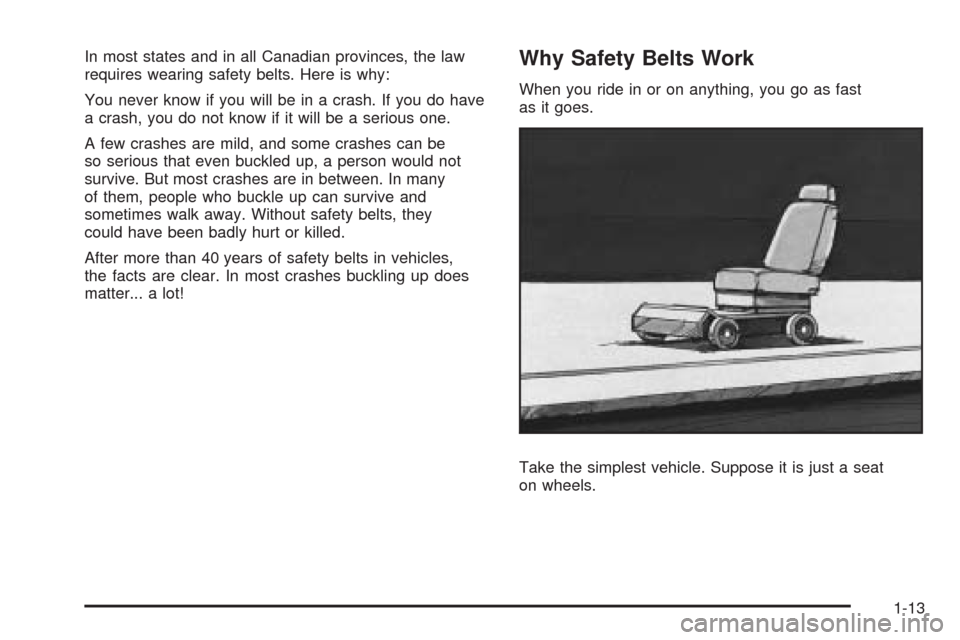
In most states and in all Canadian provinces, the law
requires wearing safety belts. Here is why:
You never know if you will be in a crash. If you do have
a crash, you do not know if it will be a serious one.
A few crashes are mild, and some crashes can be
so serious that even buckled up, a person would not
survive. But most crashes are in between. In many
of them, people who buckle up can survive and
sometimes walk away. Without safety belts, they
could have been badly hurt or killed.
After more than 40 years of safety belts in vehicles,
the facts are clear. In most crashes buckling up does
matter... a lot!Why Safety Belts Work
When you ride in or on anything, you go as fast
as it goes.
Take the simplest vehicle. Suppose it is just a seat
on wheels.
1-13
Page 18 of 462
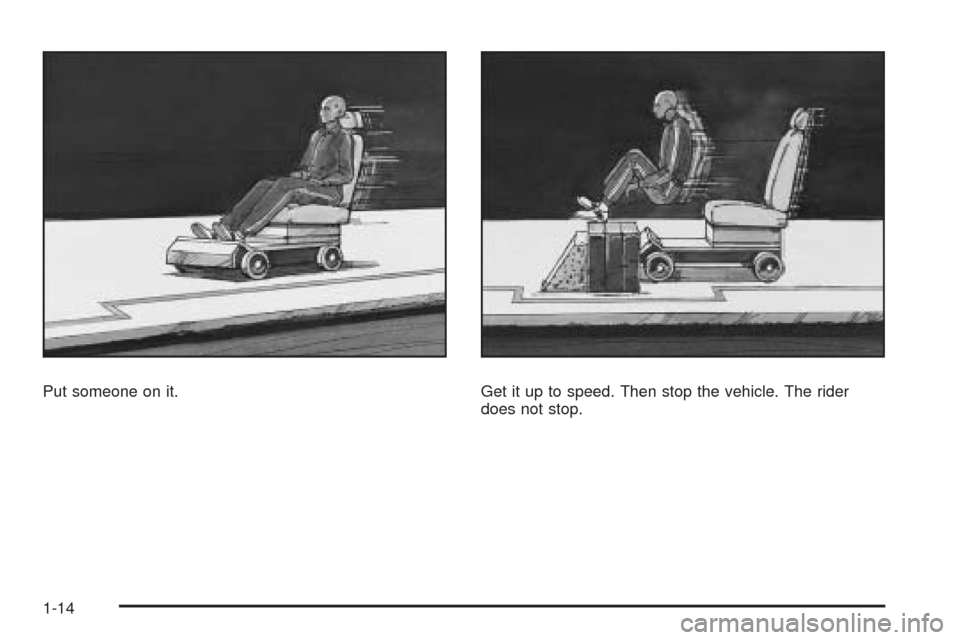
Put someone on it. Get it up to speed. Then stop the vehicle. The rider
does not stop.
1-14
Page 19 of 462
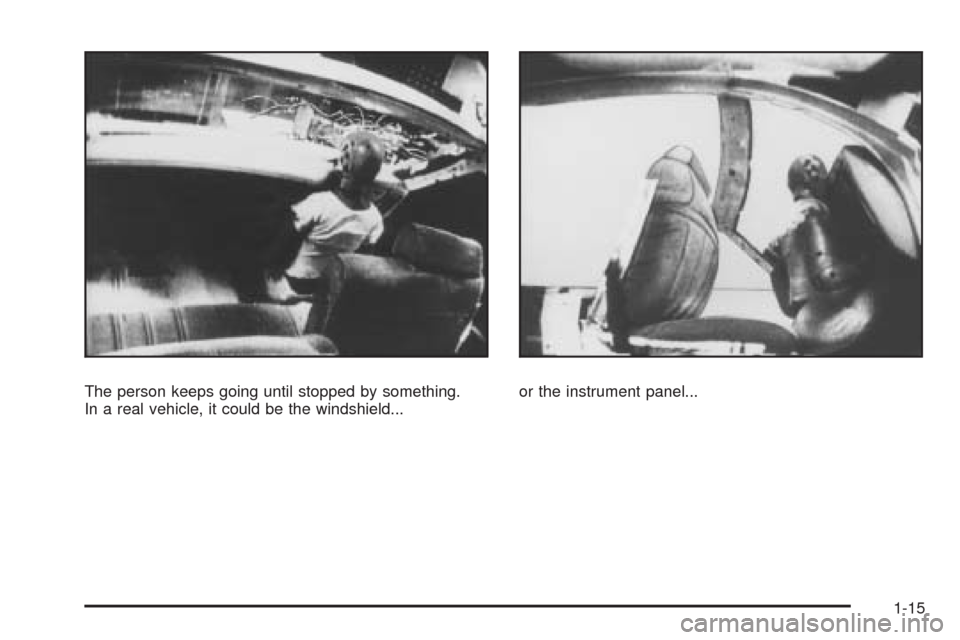
The person keeps going until stopped by something.
In a real vehicle, it could be the windshield...or the instrument panel...
1-15
Page 20 of 462

or the safety belts!
With safety belts, you slow down as the vehicle does.
You get more time to stop. You stop over more distance,
and your strongest bones take the forces. That is why
safety belts make such good sense.
Questions and Answers About Safety
Belts
Q:Will I be trapped in the vehicle after a crash if I
am wearing a safety belt?
A:Youcouldbe — whether you are wearing a safety
belt or not. But your chance of being conscious
during and after an accident, so youcanunbuckle
and get out, ismuchgreater if you are belted.
And you can unbuckle a safety belt, even if you are
upside down.
Q:If my vehicle has airbags, why should I have to
wear safety belts?
A:Airbags are supplemental systems only; so they
workwithsafety belts — not instead of them.
Whether or not an airbag is provided, all occupants
still have to buckle up to get the most protection.
That is true not only in frontal collisions, but
especially in side and other collisions.
1-16